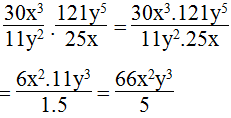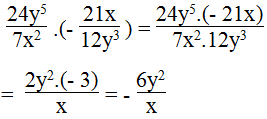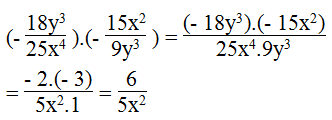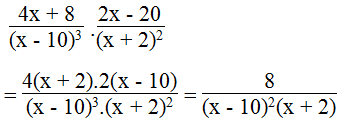Hãy nhập câu hỏi của bạn vào đây, nếu là tài khoản VIP, bạn sẽ được ưu tiên trả lời.

VÀO TCN
Loa loa, tin nóng hổi. CẶP VỢ CHỒNG SON TRẺ NHẤT VIỆT NAM ĐÂY
https://olm.vn/thanhvien/nhu140826
https://olm.vn/thanhvien/trungkienhy79
Tình yêu đã giúp cho hai anh chị 2k6 này bất chấp tất cả (học tập, vui chơi),nể thật.


vÀO TCN CỦA MK
Loa loa, tin nóng hổi. CẶP VỢ CHỒNG SON TRẺ NHẤT VIỆT NAM ĐÂY
https://olm.vn/thanhvien/nhu140826
https://olm.vn/thanhvien/trungkienhy79
Tình yêu đã giúp cho hai anh chị 2k6 này bất chấp tất cả (học tập, vui chơi),nể thật.



Ta có: \(x=-24\Leftrightarrow-x=24\Leftrightarrow1-x=25\)
Thay vào E ta được:
\(E=x^{20}+\left(1-x\right)x^{19}+\left(1-x\right)x^{18}+...+\left(1-x\right)x^2+\left(1-x\right)x+\left(1-x\right)\)
\(E=x^{20}+x^{19}-x^{20}+x^{18}-x^{19}+...+x^2-x^3+x-x^2+1-x\)
\(E=1\)

x=-24
=>-x=24
=>-x+1=25
thay -x+1=25 vào E ta được:
E=x20+(-x+1)x19+(-x+1)x18+(-x+1)x17+...+(-x+1)x3+(-x+1)x2+(-x+1)x+(-x+1)
=x20-x20+x19-x19+x18-x18+x17-...-x4+x3-x3+x2-x2+x-x+1
=1
Vậy với x=-24 thì E=1
x = ‐24
=> ‐ X = 24
=> ‐ X + 1 = 25
thay ‐x+1=25 vào E ta được:
E = x 20 + ﴾‐ x + 1﴿ x 19 + ﴾‐ x + 1﴿ x 18 + ﴾‐ x + 1﴿ x 17 + ... + ﴾‐ x + 1﴿ x 3 + ﴾‐ x + 1 ﴿ x 2 + ﴾‐ x + 1﴿ x + ﴾‐ x + 1﴿
= x 20 ‐x 20 + x 19 ‐x 19 + x 1 8 ‐x 18 + x 17 ‐...‐ x 4 + x 3 ‐x 3 + x 2 ‐x 2 + x‐x + 1
= 1
Vậy với x=‐24 thì E=1
Học tốt nha Nguyễn Quang Linh

a,\(=x^3+x^2-\left(31x^2+31x\right)\)
\(=x^2\left(x+1\right)-31x\left(x+1\right)\)
\(=\left(x^2-31x\right)\left(x+1\right)=\left(31^2-31^2\right)\left(31+1\right)=0\)
b, Phân tích 3 số hạng đầu ta có:\(=x^5-x^4-\left(14x^4-14x^3\right)=\left(x^4-14x^3\right)\left(x-1\right)=\left(14^4-14^4\right)\left(x-1\right)=0\)
Thay x= 14 vào ta có: \(-29.14^2+13.14=-5502\)
c, do x=9 => x+1=10; Thay vào ta có:
\(C=x^{14}-\left(x+1\right)x^{13}+\left(x+1\right)x^{12}-...+\left(x+1\right)x^2-\left(x+1\right)x+10\)
\(C=x^{14}-x^{14}-x^{13}+x^{13}+x^{12}-....+x^3+x^2-x^2-x+10\)
\(C=-x+10=-9+10=1\)
CHÚC BẠN HỌC TỐT.....

b: \(=\left(5x-\dfrac{1}{5}y\right)^2=\left(5\cdot\dfrac{-1}{5}+\dfrac{1}{5}\cdot5\right)^2=0\)
c: \(=x^2-20x+100-x^2-80x\)
\(=-100x+100=-98+100=2\)

a, \(ĐKXĐ:x\ne\pm\frac{1}{5},x\ne\frac{3}{2}\)
\(\Rightarrow P=\frac{\left(5x+1\right)\left(x+2\right)}{\left(2x-3\right)\left(5x-1\right)\left(5x+1\right)}-\frac{\left(8-3x\right)\left(5x+1\right)}{\left(5x-1\right)\left(5x+1\right)\left(2x-3\right)}\)
\(=\frac{x+2}{\left(2x-3\right)\left(5x-1\right)}-\frac{8-3x}{\left(5x-1\right)\left(2x-3\right)}\)
\(=\frac{2\left(2x-3\right)}{\left(2x-3\right)\left(5x-1\right)}=\frac{2}{5x-1}\)
b, Để P có giá trị nguyên thì \(2⋮5x-1\)
\(\Rightarrow5x-1\in\left\{1,2,-1,-2\right\}\)
=> x=..............
ĐKXĐ : x \(\ne\frac{3}{2}\) ; \(x\ne\frac{1}{5};x\ne-\frac{1}{5}\)
P= \(\frac{5x+1}{2x-3}.\left(\frac{x+2}{25x^2-1}-\frac{8-3x}{25x^2-1}\right)\)
P= \(\frac{5x-1}{2x-3}.\left(\frac{4x-6}{\left(5x+1\right).\left(5x-1\right)}\right)\)
P= \(\frac{5x-1}{2x-3}.\frac{2\left(2x-3\right)}{\left(5x-1\right)\left(5x+1\right)}\)
P= \(\frac{2}{5x-1}\)
KL






a) Với x = 24
=> x + 1 = 24 (1)
Thay (1) vào A ta được:
\(A=x^{10}-\left(x+1\right)x^9+\left(x+1\right)x^8-\left(x+1\right)x^7+...+\left(x+1\right)x^2-\left(x+1\right)x+x+1\)
\(A=x^{10}-x^{10}-x^9+x^9+x^8-x^8-x^7+...+x^3+x^2-x^2-x+x+1\)
\(A=1\)
b) Với x = 31
=> x - 1 = 30 (1)
Thay (1) vào B ta được
\(B=x^3-\left(x-1\right)x^2-\left(x-1\right)x+1\)
\(B=x^3-x^3+x^2-x^2+x+1\)
\(B=x+1\)
\(B=31+1=32\)
c) Với x = 14
=> x + 1 = 15
x + 2 = 16
2x + 1 = 29
x - 1 = 13
Thay tất cả biểu thức trên vào C ta được
\(C=x^5-\left(x+1\right)x^4+\left(x+2\right)x^3-\left(2x+1\right)x^2+\left(x-1\right)x\)
\(C=x^5-x^5-x^4+x^4+2x^3-2x^3-x^2+x^2-x\)
\(C=-x\)
\(C=-14\)
d) Ta có:
\(\left(-2+x^2\right)\left(-2+x^2\right)\left(-2+x^2\right)\left(-2+x^2\right)\left(-2+x^2\right)=1\)
\(\Rightarrow\left(-2+x^2\right)^5=1\)
\(\Rightarrow-2+x^2=1\)
\(\Rightarrow x^2=1+2=3\)
\(\Rightarrow\left[{}\begin{matrix}x=\sqrt{3}\\=-\sqrt{3}\end{matrix}\right.\)